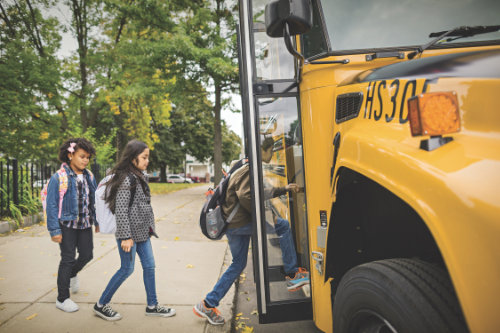4 benefits of propane school buses
Protecting students as they travel to and from school takes many forms. Parents and educators alike teach kids to be mindful of traffic and responsible while riding and waiting at the bus stop. Drivers are trained to avoid accidents to safeguard the children in their care. Another way to protect kids traveling to and from school involves the mode of transportation they use.
According to the National Transportation Safety Board, 25 million children across the country ride to school every day in nearly 500,000 school buses. Yet the way kids ride to school today is very much the way children rode to school 25 years ago, in an aging diesel school bus. These buses are not only expensive to operate, they also pose potential harm to children’s health, the community and the environment.
While there are diverse energy options that can achieve cleaner, healthier school transportation, propane is an environmentally friendly and affordable energy source.
“With significant investments being made to clean up the nation’s school bus fleet, such as the Environmental Protection Agency’s Clean School Bus Program, there’s never been a better time to prioritize clean transportation,” said Tucker Perkins, president and CEO for the Propane Education & Research Council. “Affordable and available solutions, like propane, should be implemented immediately to move further down the path to zero emissions and decarbonize our nation’s school bus fleets.”
At BetterOurBuses.com you can learn how to open dialogue with your school district about clean transportation by sharing the benefits of propane school buses, including:

Student Health
Propane buses are better for children’s health compared to diesel buses because they reduce harmful pollutants. The cloud of black smoke that comes from the tailpipe of a diesel bus contains harmful emissions like nitrogen oxide and particulate matter. Propane buses eliminate that issue, reducing harmful nitrogen oxide emissions by up to 96% compared to diesel and emitting near-zero particulate matter emissions.
Beyond the implications for asthma, bronchitis and other respiratory problems, propane school buses provide a quieter ride than diesel buses, which means those driving children to school are better equipped to hear potential concerns and protect riders’ safety.

The Environment
Propane reduces harmful emissions that impact student health, the environment and air quality in the community. It is a low-carbon energy source that can accelerate decarbonization of the nation’s school bus fleet. It is also non-toxic to groundwater and soil. Both propane and electric vehicles can reduce emissions compared to diesel, but propane does it at a fraction of the cost. School districts can buy three propane buses for the cost of one electric bus, allowing them to retire aging diesel buses three times faster by choosing propane.

Cost Savings
Propane school buses are an affordable option for school districts. The operating cost of propane school buses are half the cost of diesel, allowing school districts to put more money back into the classroom. If all the diesel buses in the U.S. were converted to operate on propane, enough money could be saved to hire 23,000 teachers.

Reliability
Propane has a range of 400 miles, which makes it a good choice for vehicles like school buses, which need to travel long distances without stopping to recharge or refuel, providing a reliable ride for students. Propane school buses also have the power and performance to travel in all kinds of weather and across all types of terrain while diesel and electric buses can be impacted by freezing weather.














